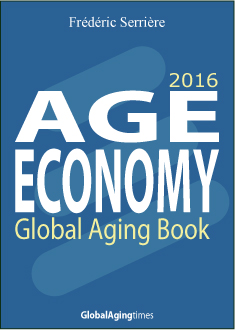The fabric of the world today, almost two decades into the 21st century, is profoundly different than ever seen before. With an almost frenetic pace of change and technological advancement, an aging society and the massive urbanization movement, many of the structures of society have not evolved in-step and no longer adequately serve its needs.
By Peter R. Nicholson, Vice President, Business Development & Strategy
Healthcare is a good example. We need to reflect a more holistic approach to wellness by focusing resources to protect and enhance good health while being able to intervene when health becomes compromised. Through sensors, imaging, information technology infrastructure and cloud computing, we now have the ability to connect stakeholders and monitor health, particularly as we age and for those who may be at risk. We need to better direct resources at addressing health issues much earlier – monitoring and early detection – when costs are lower and the intervention less invasive, to enhance quality of life through a more cost-effective paradigm. The recent strategy on aging and health, adopted by all 194 member countries of the WHO earlier this year, is an important step forward. This well-defined set of goals and objectives focuses on enhancing and sustaining functional ability through wellness and prevention, better care models and earlier treatment paradigms. It also links public health goals to economic growth, essential for success in our aging society.
Work policy and the concept of retirement, however, are areas where we continue to lag far behind society’s need in the 21st century. The concept of retirement as we know it today is outdated and based on the now iconic number of 65. In 1881 Otto von Bismarck, the conservative chancellor of Prussia, presented a radical idea to the Reichstag: government-run financial support for older members of society. In other words, health and financial benefits in retirement. The idea was radical because back then, people simply did not retire. If you were alive, you worked—probably on a farm—or, if you were wealthier, managed a farm or larger estate. Coupled with the workers’ compensation program established in 1884 and the “sickness” insurance enacted the year before, by 1889 Bismarck had created a comprehensive system of income security based on social insurance principles. While these benefits were originally proposed to begin at the age of 70, the age was lowered to 65 in 1916, when life expectancy was 50 for men and 54 for women. A quick calculation shows that the likelihood of people claiming those benefits was pretty low at that time.
Today, 100 years later, the retirement age of 65 (more or less) still stands while in countries with developed economies and increasingly around the globe, life expectancy runs well into the 80’s for both men and women. Thus there is a very high likelihood that many people will claim these benefits, and for many years. In fact, across Europe, in Japan and the U.S., children born in the 1990s have a good chance of seeing three centuries. If people are to routinely live into their 80s, 90s or more, we need to rethink the concepts of work and retirement to better reflect the reality of population age structures and therefore the needs of society in the 21st century. How do we proceed, today, in a manner that is fiscally sustainable?
I was fortunate to participate this past week in a workshop focused on this very topic at the Harris Manchester College, Oxford University, co-chaired by Elizabeth Isele, CEO of the Global Institute for Experienced Entrepreneurship (GIEE), and Michael Hodin, CEO of the Global Coalition on Aging (GCOA).
The discussion below is the output from this event and does not necessarily represent my employer’s views or activities, so don’t take them to task. Rather, these are summary reflections from a talented and experienced group of people who came together to discuss this topic. Our workshop included members from government, academia, public institutions, industry and the media who each brought their collective experience, insights and knowledge together in a multi-disciplinarian approach to think about how to better engineer work practices and the concept of retirement.
From our discussion, it was clear that mandatory retirement at 65 is not best suited to allow people and companies to thrive. Additionally, the budget implications of providing benefits to a significant segment of the population for 20-30 years or more is unsustainable. However, arbitrarily setting the retirement age to a different, older level, misses the point.
As workers hit their fifties, many of today’s organizations begin to categorize them as ‘old’ and thus treat them differently. Paradoxically this is precisely the moment when they have their greatest depth and breadth of experience as well as organizational wisdom. As these older workers approach the age-limit set for retirement, whatever it may be, they are forced to exit the workplace. For some, this is a seen as a just reward for a many years of effort. However, for others this is unfair – they want or need to keep working! Planned obsolescence – retirement – for workers at this most valuable stage in life and job status is ill fitted for society’s needs today and we need to change this.
At Oxford we were clear that the experience of working for 25 years or more creates employees with valuable insights that make them increasingly more productive, often wiser, and certainly with knowledge and experience for mentorship of younger colleagues coming into an organisation. The consensus view was that what we need is flexibility in the workplace. While the ability to remain engaged and productive in a professional setting is valued by many, the ability to do so part-time, with different pay structures as well, could be the key that unlocks the deep pools of productivity otherwise lost through mandatory retirement to contribute significant economic growth and provide competitive advantages to the employers who make these changes. Part-time engagement for senior members of the workforce could benefit cross-generational entrepreneurship for new company formation and intrapreneurship to reignite growth and provide new products and channels for unmet needs by leveraging the talent pool and assets within an organization.
During the seminar, there was a significant level of sharing of data and examples where, when these type of activities are supported, new value is created in addition to competitive advantages for those employers with the foresight to change. The concepts of part-time engagement and mentorship stood out as clear and compelling ways through which work practices could be re-engineered to deliver benefits to all stakeholders and to society overall. Globally, birthrates have fallen in all “developed economies” to well-below the population replacement level of 2.1. Thus we will have a shrinking labor force from which to draw on in there future and the need to create an environment that supports continued worker engagement for older citizens. The discussion at Oxford concluded that this issue is at the intersection of employee fulfilment, employer self-interest and society-shared value.
Given the urgency of the issues and opportunities represented by our aging population, and the need to rethink the way the world “works” today, change will likely come here first, where it is most needed. However, as this change takes hold, it will likely start to ‘trickle down’ to impact other workers who may also want to have a different work contract with their employers and overall with society. The ability to move in and out of the workforce, from full-time to part-time and back again, or to take a break, can be one way for people to retain a longer horizon of productive engagement and make greater contributions while empowering them to evolve professionally and personally for a richer and more fulfilling life. To me, that seems profound yet achievable and something worth striving for.


